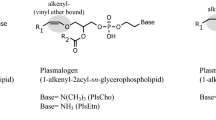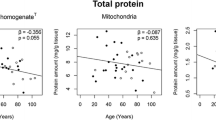Abstract
This paper shows for the first time the differential fatty acid composition of ethanolamine plasmalogens (EP) and phosphatidylethanolamine (PE) in the brains of 12 patients with disorders of peroxisomal biogenesis and compares the results to normal values for the age. Other important glycerophospholipids (GPL), such as phosphatidylserine (PS) and phosphatidylcholine (PC), are also included in this study. GPL were separated by two-dimensional thin-layer chromatography, and their fatty acid composition was determined by capillary column gas-liquid chromatography. Total brain GPL were slightly decreased in peroxisomal disorders (27.98±2.95 μmol/g in the patients against 34.5±6.21 μmol/g in age-matched controls, P=0.005), and the distribution of the different GPL classes was much altered. In confirmation of known data, EP were very much decreased (2.18±1.3 μmol/g in the patients against 6.9±2.3 μmol/g in controls) at the expense of PE, which was increased (8.58±2.17 μmol/g in the patients against 5.97±0.58 μmol/g in controls, P<0.005). PS and PC were both significantly decreased (P=0.0001 and P=0.037, respectively). The polyunsaturated fatty acid (PUFA) composition of all the GPL fractions was markedly abnormal. In absolute terms, docosahexaenoic acid (22∶6n−3) was drastically decreased in all GPL classes (always at the P<0.0001 level) while arachidonic acid (20∶4n−6) was increased in PE and PS (P<0.001 in both cases). In the alkenyl acyl form, EP, 22∶6n−3, and 20∶4n−6 were both very significantly decreased (P<0.0001), although the former was always the most affected. The myelin PUFA adrenic acid (22∶4n−6) was decreased in EP (P<0.0001) and slightly increased in PS (P<0.05). The changes found confirm that 22∶6n−3 deficiency is a predominant defect in the brain in peroxisomal disorders.
Similar content being viewed by others
Abbreviations
- DHA:
-
docosahexaenoic acid
- EP:
-
ethanolamine plasmalogens
- FAME:
-
fatty acid methyl esters
- GPL:
-
glycerophospholipid
- PC:
-
phosphatidylcholine
- PE:
-
phosphatidylethanolamine
- PS:
-
phosphatidylserine
- PUFA:
-
polyunsaturated fatty acid(s)
- TLC:
-
thin-layer chromatography
- ZS:
-
Zellweger’s syndrome
References
Bowen, P., Lee, C.S.M., Zellweger, H., and Lindenberg, R. (1964) A Familial Syndrome of Multiple Congenital Defects, Bull. Johns Hopkins Hosp. 114, 402–414.
Goldfischer, S., Moore, C.L., Johnson, A.B., Spiro, A.J., Valsmis, M.P., Wisniewski, H.K., Ritch, R.H., Norton, W.T., Rain, I., and Gartner, L.M. (1973) Peroxisomal and Mitochondrial Defects in the Cerebro-Hepato-Renal Syndrome, Science 182, 62–64.
Brown, F.R., McAdams, A.J., Cumins, J.W., Konkol, R., Singh, I., Moser, A.B., and Moser, H.W. (1982) Cerebro-Hepato-Renal (Zellweger) Syndrome and Neonatal Adrenoleukodystrophy: Similarities in Phenotype and Accumulation of Very Long Chain Fatty Acids, Johns Hopkins Med. J. 151, 344–361.
Singh, I., Moser, A.B., Goldfischer, S., and Moser, H.W. (1984) Lignoceric Acid Is Oxidized in the Peroxisome: Implications for the Zellweger Cerebro-Hepato-Renal Syndrome and Adrenoleukodystrophy, Proc. Natl. Acad. Sci. USA 81, 4203–4207.
Heymans, H.S.A., Schutgens, R.B.H., Tan, R., van den Bosch, H., and Borst, P. (1983) Severe Plasmalogen Deficiency in Tissues of Infants Without Peroxisomes (Zellweger syndrome), Nature 306, 69–70.
Hajra, A.K., and Bishop, J.E. (1982) Glycerolipid Biosynthesis in Peroxisomes via the Acyl Dihydroxyacetone Phosphate Pathway, Ann. NY Acad. Sci. 386, 170–182.
Poulos, A., Sharp, P., Fellenberg, A.J., and Danks, D.M. (1985) Cerebro-Hepato-Renal (Zellweger) Syndrome, Adrenoleukodystrophy and Refsum’s Disease: Plasma Changes and Skin Fibroblast Phytanic Acid Oxidase, Hum. Genet. 70, 172–177.
Hanson, R.F., Szczepanik-van Leeuwen, P., Williams, G.C., Grabowski, G., and Sharp, H.L. (1979) Defects of Bile Acids Synthesis in Zellweger’s Syndrome, Science 203, 1107–1108.
Powers, J.M., and Moser, H.W. (1998) Peroxisomal Disorders: Genotype, Phenotype, Major Neuropathologic Lesions, and Pathogenesis, Brain Pathol. 8, 101–120.
Jaffe, R., Crumrine, P., Hashida, Y., and Moser, H.W. (1982) Neonatal Adrenoleukodystrophy: Clinical, Pathologic, and Biochemical Delineation of a Syndrome Affecting Both Males and Females, Am J. Pathol. 108, 100–111.
Scotto, J.M., Hadchouel, M., Odievre, M., Landat, M.H., Saudubray, J.M., Dulac, O., Beucler, Y., and Beaune, P. (1982) Infantile Phytanic Acid Storage Disease, a Possible Variant of Refsum’s Disease: Three Cases, Including Ultrastructural Studies of the Liver, J. Inher. Metab. Dis. 5, 83–90.
Moser, A.B., Rasmussen, M., Naidu, S., Watkins, P.A., McGuinness, M., Hajra, A.K., Chen, G., Raymond, G., Liu, A., Gordon, D., Garnaas, K., Walton, D.S., Skjeldal, O.H., Guggenheim, M.A., Jackson, L.G., Elias, E.R., and Moser, H.W. (1995) Phenotype of Patients with Peroxisomal Disorders Subdivided into Sixteen Complementation Groups, J. Pediatr. 125, 755–767.
Martinez, M. (1989) Polyunsaturated Fatty Acid Changes Suggesting a New Enzymatic Defect in Zellweger Syndrome, Lipids 24, 261–265.
Martinez, M. (1990) Severe Deficiency of Docosahexaenoic Acid in Peroxisomal Disorders: A Defect of D4 Desaturation? Neurology 40, 1292–1298.
Martinez, M. (1992) Abnormal Profiles of Polyunsaturated Fatty Acids in the Brain, Liver, Kidney and Retina of Patients with Peroxisomal Disorders, Brain Res. 583, 171–182.
Breckenridge, W.C., Gombos, G., and Morgan, I.G. (1972) The Lipid Composition of Adult Rat Brain Synaptosomal Plasma Membranes, Biochim. Biophys. Acta 266, 695–707.
Anderson, R.E., Benolken, R.M., Dudley, P.A., Landis, D.J., and Wheeler, T.G. (1974) Polyunsaturated Fatty Acids of Photoreceptor Membranes, Exp. Eye Res. 18, 205–213.
Martinez, M., and Mougan, I. (1998) Fatty Acid Composition of Human Brain Phospholipids During Normal Development, J. Neurochem. 71, 2528–2533.
Horrocks, L.A., and Sun, G.Y. (1972) Ethanolamine Plasmalogens, in Research Methods in Neurochemistry, Vol. 1 (Marks, N., and Rodnight, R., eds.), pp. 223–231, Plenum, New York.
Lepage, G., and Roy, C.C. (1986) Direct Transesterification of All Classes of Lipids in a One-Step Reaction, J. Lipid Res. 27, 114–120.
Martinez, M., Mougan, I., Roig, M., and Ballabriga, A. (1994) Blood Polyunsaturated Fatty Acids in Patients with Peroxisomal Disorders. A Multicenter Study, Lipids 29, 273–280.
Balazy, M., and Nies, A.S. (1989) Characterization of Epoxides of Polyunsaturated Fatty Acids by Mass Spectrometry via 3-Pyridinylmethyl Esters, Biomed. Environ. Mass. Spectrom. 18, 1328–1336.
Martinez, M., Ballabriga, A., and Gil-Gibernau, J.J. (1988) Lipids of the Developing Human Retina: I. Total Fatty Acids, Plasmalogens, and Fatty Acid Composition of Ethanolamine and Choline Phosphoglycerides, J. Neurosci. Res. 20, 484–490.
Crawford, M.A., Casperd, N.M., and Sinclair, A.J. (1976) The Long-Chain Metabolites of Linoleic and Linolenic Acids in Liver and Brain in Herbivores and Carnivores, Comp. Biochem. Physiol. [B] 54, 395–401.
Svennerholm, L. (1968) Distribution and Fatty Acid Composition of Phosphoglycerides in Normal Human Brain, J. Lipid Res. 9, 570–579.
Jones, C.R., Arai, T., and Rapoport, S.I. (1997) Evidence for the Involvement of Docosahexaenoic Acid in Cholinergic Stimulated Signal Transduction at the Synapse, Neurochem. Res. 22, 663–670.
Martinez, M. (1998) Docosahexaenoic Acid Ethyl Ester as a Treatment for Patients with Generalized Peroxisomal Disorders, in Lipids in Infant Nutrition (Huang, Y.S., and Sinclair, A.J., eds.), pp. 29–38, AOCS Press, Champaign.
Martinez, M., and Vázquez, L. (1998) Treatment with Docosahexaenoic Acid Ethyl Ester Improves Myelination in Patients with Generalized Peroxisomal Disorders, Neurology 51, 26–32.
Hanada, E., and Suzuki, K. (1980) Specificity of Galactosylceramidase Activation by Phosphatidylserine, Biochim. Biophys. Acta 619, 396–402.
Hajra, A.K., Bowen, D.M., Kishimoto, Y., and Radin, N.S. (1966) Cerebroside Galactosidase of Brain, J. Lipid Res. 7, 379–386.
Author information
Authors and Affiliations
About this article
Cite this article
Martinez, M., Mougan, I. Fatty acid composition of brain glycerophospholipids in peroxisomal disorders. Lipids 34, 733–740 (1999). https://doi.org/10.1007/s11745-999-0420-6
Received:
Revised:
Accepted:
Issue Date:
DOI: https://doi.org/10.1007/s11745-999-0420-6




